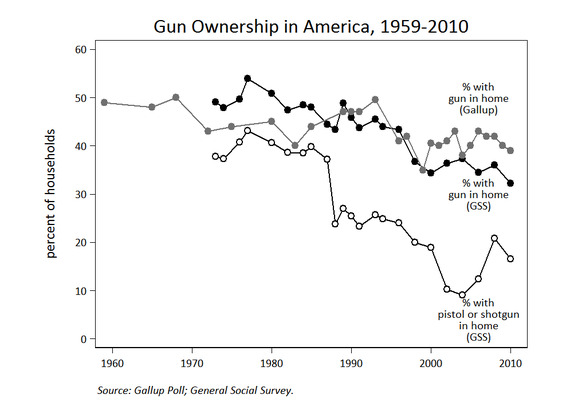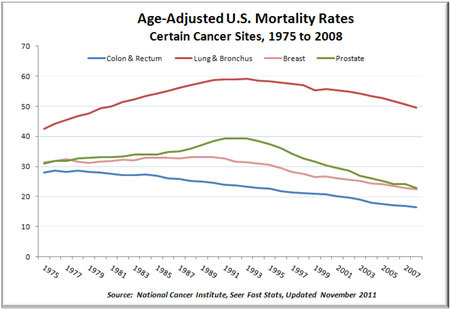Ok. I get it. The world sucks! Among ISIS, Ebola, climate change and constant political in-fighting, we live in a pretty screwed-up world, and the news media wants to remind us of this every day because bad news attracts more interest than good news. But there is a price we pay for the incessant drumroll of negative news and points-of-view. We think the world is more violent, uncaring and frightening than objective evidence shows it actually is. For example, when Ebola hogs the lion's share of news reports in the United States, but the Enterovirus D68 is only a footnote despite its actual surging infection rate, you know we have lost any real perspective on personal risks.
Life expectancy increasing: World Health Organization says the average global life expectancy has increased from 64 years in 1990 to 70 years in 2011. This continues a 200-year trendworldwide for the last 200 years. And for the US increases, it went from 78.1 in 2008 to 78.4 in 2009.
 Fewer people with guns (Credit:Gallop Poll)
Fewer people with guns (Credit:Gallop Poll)
Gun ownership declining - The proportion of households with a firearm has been in slow decline over the last quarter century. The percent of adults living in a household with a gun fell from a high of 50% in the 1970 to a low of 34% in 2012. This explains the increasing stridency of the NRA which is losing potential membership.
Cellphones and the internet increasing - According to eMarketer, 63% of the world population uses cellphones in 2014. That number is steadily increasing by about 2% per year. According to InternetWorldStats, 40% of the human population used the internet in 2013, and this is growing by about 3% per year.
Infant mortality declining - According to the WHO,worldwide, vaccination campaigns, better sanitation, and wider use of medicine have cut worldwide infant mortality rates from 63 deaths per thousand in 1990, to 34 per thousand in 2013.
Abortions declining - According to a study by the WHO, there has been a modest decline in the worldwide abortion rate, from 35 per 1,000 women aged 15-44 in 1995 to 29 per 1,000 in 2003. Some cancers are in decline (Credit: National Cancer Institute)
Some cancers are in decline (Credit: National Cancer Institute)
Cancer declining - According to the National Cancer Institute, for the first time in more than 70 years, annual cancer deaths in the United States have fallen to 556,902 in 2003, from 557,271 in 2002. In 2003 the 5-year survival rate was 66.7% but by 2020 this is expected to increase to 72.8%. Death rates have fallen for lung, breast, prostate and colorectal cancer.
Heart disease declining - The drop from 307 per thousand in 1950 to 134 per thousand in 1996 is credited to all that exercise, dieting, quitting smoking, new drugs, and new technologies that are now routinely in use according to researchers at the Center for Disease Control.
Urbanization increasing - According to the Post-Gazette, by 2007 nearly all the world's population growth will occur in urban areas at an average of 1.8 percent annually.
Green energy increasing - According to Vital Signs 2001:The trends that are shaping our future by the World Watch Institute, "...ten times as much electricity is generated through wind power now as in 1990, and production of photovoltaic or solar cells is 10 times larger than in 1987" [p.24]. In the year 2050, renewable green energy sources may account for 78 percent of total human energy needs.
Literacy increasing - According to UNESCO, the world-wide literacy rate among adults has grown to 80 per cent for women and 89% for men by 2012, compared to 45% about 50 years ago.
Women increasing roles - According to the Pew Research Center, women not only outnumber men in college today but according to the American Institute of Physics, women have also been stepping up their study of science and math in high school and aspiring to more advanced degrees in college. There has been a 161% increase in women taking HS physics between 1987 and 2009. The percentage of women with Masters degrees in physics has increased from 10% in 1983 to 24% in 2012.
Computers getting smarter - If the current trends in computing power and speed continue, by 2019, your $1,000 computer will resemble the human brain in raw computing power, some 20 million billion calculations per second. Ten years later, developments in software applications will make your average personal computer equal to a thousand human brains. The Automaton Revolution (Scientific American)
More hazardous asteroids discovered - Showing no signs of ending anytime soon, the pace of finding new hazardous near-earth asteroidsand tracking them continues to be 40 per year. Meanwhile the discovery of very large asteroids has been declining steadily as we reach the 90%-discovered limit. With the exception of comets, we now know where just about all the extinction-level asteroids are located and their hazard potential.
Ozone hole decreasing - Following a sharp decline between 1980 and 1995, the concentration of Antarctic ozone has been steadily increasing since 2005, and if the healing continues, it will reach its 1980 abundances in a few more decades, making the 'hole' a thing of the past and a major success in humans fixing a problem they themselves created using CFCs for air conditioning and under-arm deodorants! This decrease is in step with dramatic atmospheric chlorine reductions measured since 1996.
 We are even seeing these planets directly like the ones orbiting the star HR8799!(Credit: NASA/JPL-Caltech/Palomar Observatory)
We are even seeing these planets directly like the ones orbiting the star HR8799!(Credit: NASA/JPL-Caltech/Palomar Observatory)
Planets beyond solar system increasing - Since 1995 the pace of discovering planets beyond our solar system has been growing at a near-exponential pace. The number is doubling every three years and is now over 4000 known or suspected planets of which 400 are earth-sized.
Astronauts spending more time in space - Humans have spent a total of nearly 45,000 person-days in orbit, and with the International Space Station, this is increasing by about 2,200 person-days every year.
So the next time you can't take the bad news anymore, give your brain a rest and consider some of the good things going on too!
